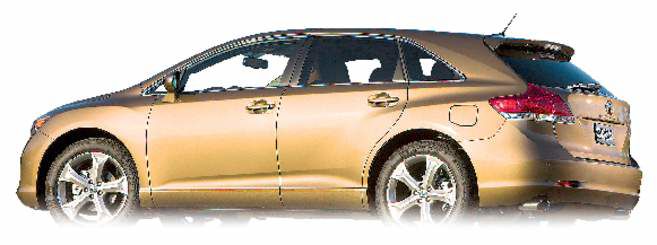A disguise that works
Published 4:00 am Sunday, January 4, 2009

- Toyota via The Associated Press
The 2009 Toyota Venza is the latest attempt by automakers to cloak a station wagon in a new, modern vehicle’s clothing. And you know what? This time, it worked.
From its wide, comfortable front seats, taller-than-a-car views and well-arranged gauges and controls to its 70.1 cubic feet of cargo space and fuel-thrifty engines, the Venza is a welcome addition to the burgeoning crossover sport utility vehicle segment.
In fact, in a break with most competitors, the Venza even looks less like a normal SUV, really, and more like a tall, but not too bulky, car.
The five-passenger, 2.7-liter four-cylinder Venza does have a higher starting retail price than the competing crossovers such as 2009 Mazda CX-7 with a higher-powered, turbo four-cylinder, and the 2009 Nissan Murano with V-6. But it’s for somewhat good reason, as the Venza comes with some features not usually considered standard. More on that later.
Venza is a combination of the word “venture” and Monza, which denotes a sporting nature. But despite its flared wheel wells, large, standard 19-inch tires and snarly chrome-covered grille, the Venza seems more like an accommodating, no-fuss driver with a compliant ride than a sporty performer.
It’s based on the Toyota’s top-selling car, the front-wheel-drive Camry, though the Venza is offered in both front- and all-wheel-drive. The all-wheel-drive system and some suspension bits are borrowed from Toyota’s second best-selling SUV, the Highlander.
Meantime, the Camry’s 2.4-liter, four-cylinder engine is the basis for the new 2.7-liter four that’s in the Venza, while the Venza’s 3.5-liter V-6 is the same V-6 that’s in the Camry and Highlander. In the Venza, this V-6 affords a towing capacity of 3,500 pounds — the same towing capacity as the Highlander. In other words, the 15.75-foot-long Venza isn’t structurally far from two of Toyota’s stalwart vehicles.
But the Venza’s exterior and interior styling are new.
I liked everything about the inside of the Venza. At 5 feet 4, I opened the door and settled down only about 2 inches to get onto the seat. Yet views out were better than that in a lower-riding Camry. The Venza is 5.5 inches taller than a Camry.
Drivers do need to be aware of the large metal pillars that are on each side of the Venza windshield, however. Drivers need to crane their necks around the left pillar in particular to ensure no pedestrians are in the way during left-hand turns.
The openness of the dashboard area and the attractive, optional leather trim on the test vehicle’s seats helped create an upscale feel. So did the quiet interior. There was some road noise, but it wasn’t overwhelming, and wind noise at highway speeds was nicely muted.
The Venza’s standard features include dual climate control, tilt and telescoping steering wheel, carbon fiber-style interior trim, tonneau cover over the cargo, sun visors with sliding extensions, AM/FM audio system with six-disc changer and rear spoiler — all goodies.
Nearly all safety features, including frontal, side and curtain air bags and a driver’s knee air bag are standard. Toyota officials note the Venza is the first Toyota with the company’s Star Safety System that combines an advanced version of electronic stability control, traction control, antilock brakes and other brake controls.
The test vehicle had the base, four-cylinder engine that’s basically a bored out version of the 2.4-liter four in the Camry. In the Venza, the larger-displacement engine develops 182 horsepower and 182 foot-pounds of torque at 4,200 rpm. This moved the front-wheel-drive Venza, which weighs about 3,800 pounds, with pep in most driving situations. There was a bit of sluggishness on mountain roads, though.
All shifts were silky smooth in the Venza, which comes with only one transmission — a six-speed automatic.
The efficient, six gears help account for the Venza’s fuel economy rating from the federal government of 21 miles per gallon in city driving and 29 mpg on the highway with the four cylinder and front-wheel-drive. Note this is the same rating that the smaller Chevrolet HHR gets and is better than the 21/27 rating of the 2009 Toyota RAV4, which is a smaller vehicle with a smaller four-cylinder engine.
Judging by the test front-wheel-drive Venza, the mileage rating appears to be realistic.
Toyota officials expect to sell 60,000 or so Venzas in the first full production year to empty nesters and others who are suffering from “SUV fatigue.” Evidently, these buyers won’t be wary of a newfangled station wagon.
2009 Toyota Venza
Base price: $25,975
As tested: $32,435
Type: Front-engine, front-wheel-drive, five-passenger, crossover sport utility vehicle
Engine: 2.7-liter, double overhead cam four cylinder with Dual VVT-i, mated to a six-speed transmission
Mileage: 21 mpg city, 29 mpg highway






